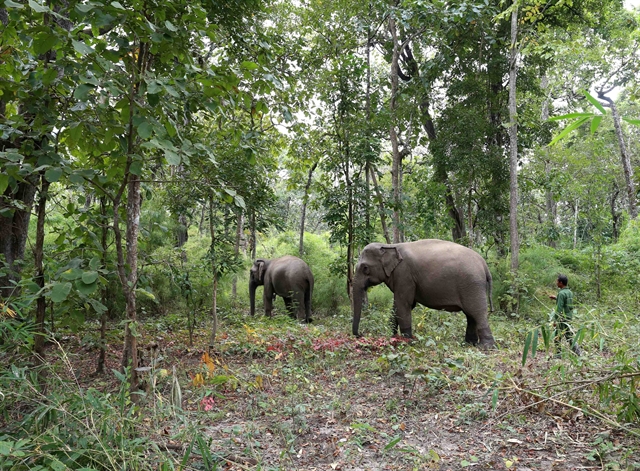 Environment
Environment

 |
| The Trà Sư forest has typical cajuput forest ecosystems and landscapes on flooded land in the western region of the Hậu River. VNA/VNS Photo Thanh Sang |
HÀ NỘI — Việt Nam is gradually perfecting its policy and legal framework to promote comprehensive actions at all levels, sectors and communities in enhancing the capacity for biodiversity conservation.
Hoàng Thị Thanh Nhàn, Deputy Director of the Ministry of Natural Resources and Environment’s Natural Conservation and Biodiversity Department, told Tài nguyên Mội trường (Natural Resources and Environment) newspaper that from now until the end of the decade would be an important period for ministries, sectors and localities to take action.
The priority solution is to continue improving policies and regulations to enhance biodiversity conservation capacity. The policy and legal framework needs to be reviewed to ensure systematic, unified and updated requirements to fulfil Việt Nam's international commitments and practical needs, according to Nhàn.
As the lead agency for the Biodiversity Convention, in 2023, the Ministry of Natural Resources and Environment submitted the draft National Biodiversity Conservation Plan for the period of 2021 - 2030, with a vision to 2050 and the draft national biodiversity strategy to 2030 with a vision towards 2050 highlighting wildlife conservation, especially endangered species to the Prime Minister for approval.
Specialised agencies are also urgently perfecting and amending related contents in Decree No08/2022/ND-CP and Circular No02/2022/TT-BTNMT providing detailed guidance and implementation of some provisions of the Environmental Protection Law. These include content on biodiversity impact assessment, biodiversity compensation, environmental heritage management and protection plans.
The system of policy and legal documents, combined with dissemination efforts to enhance awareness and responsibility for nature and biodiversity conservation, has helped promote widespread conservation activities within the community.
Many localities and businesses have made nature conservation and biodiversity a criterion for sustainable and green development. This is a positive signal for Việt Nam as building a harmonious society with nature has become a common model for many countries worldwide.
 |
| Rare primate species will become acquainted with the semi-wild environment at the Cúc Phương endangered primate rescue centre in Ninh Bình Province before being released. VNA/VNS Photo Minh Đức |
According to the Natural Conservation and Biodiversity Department, in 2024, the department will conduct a 15-year assessment of the implementation of Law on Biodiversity. This will lay the groundwork for proposing amendments to the Law on Biodiversity in 2028.
Meanwhile, research will be conducted to propose mechanisms, policies, and management measures for protecting natural landscapes, establishing management mechanisms for conservation areas beyond protected areas.
Although Việt Nam is recognised as the 16th country in terms of possessing some of the world's richest biodiversity, including rare and valuable genetic resources, it is currently grappling with swift biodiversity degradation. The nation is confronted with significant challenges such as environmental pollution, land degradation, ocean plastic pollution, and other severe impacts of climate change.
According to Phạm Minh Thảo, Director of World Wildlife Fund (WWF) Việt Nam's Program Development, while forests still exist, under the forest canopy, there is a loss of wildlife habitats and a decline in species diversity. Without timely action, many endangered species will face extinction, leading to biodiversity loss.
 |
| Elephants in the semi-wild environment model in the forest area of Krông Na Commune, Buôn Đôn District in Đắk Lắk Province. VNA/VNS Photo Vũ Sinh |
Nguyễn Mạnh Hà, Director of the Nature Conservation and Development Centre, said that the State budget currently did not adequately meet the needs for biodiversity conservation in implementing basic management and research tasks. Therefore, there was a need for a new financial mechanism and policies to attract external resources.
For example, Việt Nam could establish mechanisms to encourage the participation of Vietnamese people and businesses in investing in biodiversity conservation, or new mechanisms for ecosystem service payments outside forest ecosystems and policies to encourage individual and corporate tax contributions to biodiversity conservation.
Additionally, there was a need for biodiversity credit mechanisms, access to carbon credit markets, debt swap mechanisms for nature conservation, green bonds and green credits, he added.
Trần Quang Bảo, Director of the Forestry Department, said that in the coming time, the department would complete regulations to provide a legal basis for specialised forest management boards to implement collaborative forest leasing for businesses and individuals organising ecotourism.
Expanding the conservation system
With areas outside natural reserves lacking strict protection, Việt Nam is moving towards an integrated approach to sustainable economic development, with the participation of local communities, which will significantly increase the area of conserved ecosystems.
As part of its participation in the global biodiversity framework, Việt Nam is committed that 30 per cent of land and sea areas will be conserved through the establishment of reserves and other effective area-based conservation measures (OECMs) by 2030.
According to the International Union for Conservation of Nature (IUCN), OECMs not only help Việt Nam meet conservation commitments with the international community but also allow for the protection of highly threatened biodiversity hotspots.
 |
| Forest management and protection forces inspect chopped timber at Yok Đôn National Park in the Central Highland province of Đắk Lắk. VNA/VNS Photo Tuấn Anh |
A 2023 study identified nine potential OECMs in Việt Nam.
They are natural buffer zones of reserves; buffer zones of conservation areas; natural production forests; areas protecting fishery resources; areas with high biodiversity outside reserves; biodiversity corridors; important wetland areas; important ecological landscapes and national tourism sites.
These are significant natural landscapes with high biodiversity that have been recognised in Việt Nam's legal documents and internationally acknowledged for conservation efforts outside official reserves.
Additionally, agricultural production areas, such as shrimp-rice systems in the Mekong Delta and agroforestry systems like durian, passion fruit and avocado in the Central Highlands, can also learn from conservation initiatives both within and outside the reserve system to enhance biodiversity.
If combined with strict protection of remaining natural forests, many large areas with OECM potential can be identified, providing both biodiversity and socio-economic benefits to localities, it said.
Jake Brunner, Head of IUCN's Lower Mekong Sub-region, said: "While reserves must primarily aim for conservation, OECMs can be managed for various purposes as long as they achieve effective and long-term conservation goals.
"Structuring OECMs will not only help Việt Nam fulfil international commitments but also protect biodiversity in threatened habitats such as independent limestone mountain areas, seasonal floodplain areas, and coastal tidal flat areas that are currently underrepresented in the reserve system."
The number of OECMs in localities will be substantial due to land allocation policies to local communities. This poses challenges in defining specific boundaries, creating maps, and establishing management organisations.
To expedite OECM recognition, international organisations recommended that Việt Nam promptly develop and issue official criteria and guidelines, pilot management mechanisms for new OECM models and policies for local communities and private sectors in establishing and managing OECMs.
Moreover, applying ecosystem service payments at OECMs would be crucial for establishing sustainable financial mechanisms for biodiversity conservation, they said. — VNS




